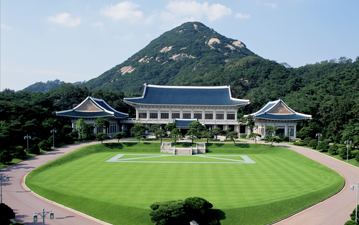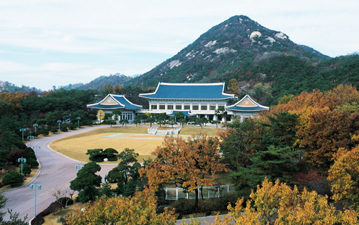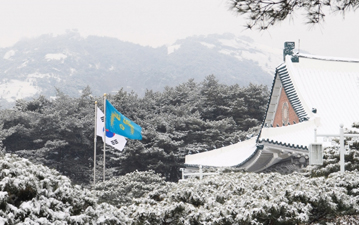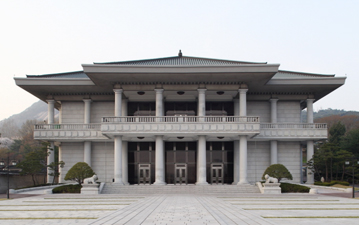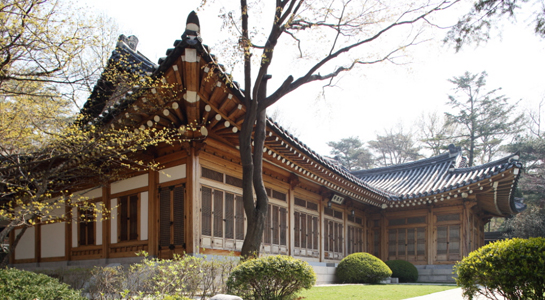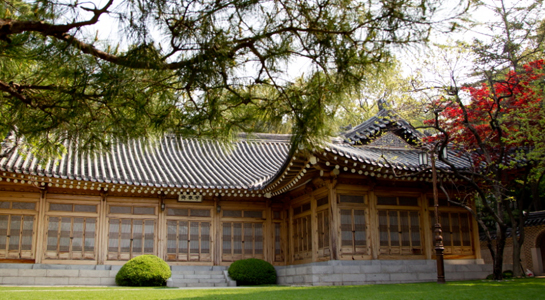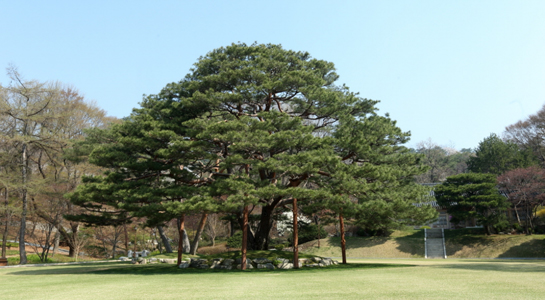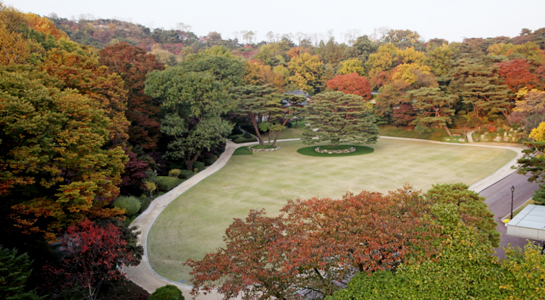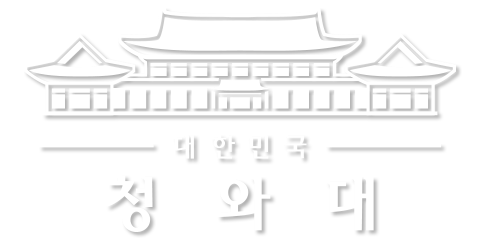이 웹사이트는 제19대 대통령 임기 종료에 따라 대통령기록관이 「대통령기록물 관리에 관한 법률」에 의해 이관받아 서비스하는 대통령기록물입니다. 자료의 열람만 가능하며 수정 · 추가 · 삭제는 불가능합니다.
다만, 「개인정보보호법」에 의하여 개인의 정보를 보호받기 원하시는 분은 관련 내용(요청자, 요청내용, 연락처, 글위치)을 대통령 웹기록물 담당자(044-211-2253)에게 요청해 주시면 신속히 검토하여 조치해 드리겠습니다. 감사합니다.
CONTACT
Cheong Wa Dae is where the President of the Republic of Korea lives and works. The compound is home to administrative offices for the President, Secretariat and other staff as well as the official residence of the President and First Lady. Cabinet meetings, receptions for state guests, critical decision-making for the country, and diplomatic events all take place here. As such, the name “Cheong Wa Dae” not only denotes a specific location but also stands for the highest authority of the Republic of Korea.
In Goryeo (918-1392), royal palace halls were on today’s Cheong Wa Dae site, and this was part of the rear garden for Gyeongbokgung, the main palace, during Joseon (1392-1910). Destroyed in the late 16th century, Gyeongbokgung was rebuilt in the mid-19th century under the orders of the regent Heungseon Daewongun, who named the site Gyeongmudae (archery range) to express wishes for officials’ literary and martial skills to flourish together. During the Japanese colonial period (1910-1945), the Governor-General’s official residence was located here, and after liberation, the Republic of Korea President began to use the site as a residence and office. It was renamed Cheong Wa Dae in 1960, and the Main Office Building was completed in 1991, giving Cheong Wa Dae its current appearance.
Main Office Building
The Main Office Building, the image of which represents Cheong Wa Dae today, was completed in 1991 and consists of a two-story central building flanked by two single-story wings. The structural design is based on traditional wood construction methods and Korean palace architectural style, while the interior projects a modern feel and boasts the latest facilities. The roof is covered by 150,000 Korean-style blue tiles crafted to last for a century or more.
Inside are various rooms dedicated to specific functions such as the President's Office; Sejong Room, where cabinet meetings are held; and Jiphyeon Room, where summit talks are convened. The sprawling lawn in front of the Main Office Building is called the Grand Garden and used for outdoor events.
State Guest House
Completed in December 1978, this is the venue for hosting official events that involve foreign guests and for holding large meetings. The structure is supported by eighteen stone pillars, which impart a stately appearance, while the interior is decorated with Rose of Sharon (national flower), laurel, and Taegeuk (the yin and yang symbol of the universe) motifs. The first floor serves as a reception room and the second floor is a dining area.
Official Residence
The First Family lives in this compound, completed in 1990 to separate the President’s working and living areas. Within these walls are a main building, detached reception hall, traditional garden, and detached sarangchae (men’s quarters). The structures feature traditional hipped-and-gabled roofs, and the signboard over the main entrance reads Insumun(仁壽門 Gate of Benevolence and Longevity).
Sangchunjae
Completed in April 1983, this traditional Korean-style structure is used for receiving foreign guests and holding unofficial meetings. It was built with wood from upright Korean red pine trees (Pinus densiflora) more than 200 years old. Inside facilities include a room with an ondol (traditional under-floor heating) system, spacious wooden-floored hall, and kitchen. Outside, royal azaleas bloom in spring, while persimmons and quinces ripen in autumn to provide a beautiful Koreanesque scene.
Nokjiwon
Completed in 1968, this garden is populated by some 120 different tree species as well as commemorative trees planted by former Presidents. The 3,300㎡ landscape has been planted with lawns for outdoor events. An umbrella pine symbolizing Nokjiwon is more than 160 years old and stands about 17m tall.
Yeomingwan
The offices of the Presidential Secretariat are collectively called Yeomingwan (與民館) and occupy three buildings. The name comes from the phrase Yeomin gorak (與民苦樂 Share the people’s hardships and joys) and promises the Government will remain close to the citizenry through good times and bad. Solar panels have been installed on the outer walls of Building 3, supplying part of the electricity consumed on site.
Chunchugwan
Chunchugwan is the Cheong Wa Dae press center, which can accommodate some 300 international and domestic journalists. The first floor has a journalist room and small briefing room, while a large briefing room is on the second floor. “Chunchugwan” (春秋館) originates from the Chinese classic Chunqiu (春秋 Spring and Autumn Annals), traditionally regarded as having been compiled by Confucius himself. The name suggests that the historical record will be strictly kept.
Map

Parking
- Personal vehicle : ground parking lot by the East Gate (2,000 won for the first two hours, 500 won for every additional 15 minutes)
-
Group tour vehicle : underground parking garage by the East Gate (4,000 won for the first two hours, 500 won for every additional 15 minutes)
(The East Gate of Gyeongbokgung Palace can be found on the left side of the street leading from Gwanghwamun to Samcheong-dong, or as you face the main Gwanghwamun Gate, it is on the right-hand wall.)
Subway
- Take exit 5 at Gyeongbokgung Station on subway line 3 into the Gyeongbokgung Palace grounds and walk approximately 600m toward the East Gate Parking Lot. The Cheong Wa Dae Tour Information Booth is on the ground parking lot.
- Every Tuesday, Gyeongbokgung Palace is closed and exit 5 should not be used. Instead, take exit 4 at Gyeongbokgung Station and walk approximately 700m in front of the Palace toward Anguk Station and turn left at the Gyeongbokgung intersection by Dongsipjagak (the East Watch Tower). The East Gate Parking Lot is on the left side of the street, and the Cheong Wa Dae Tour Information Booth is on the ground parking lot.
Bus
-
Get off at Gyeongbokgung stop
-
Blue Bus: 171, 272, 109, 601, 606
-
Green Bus: 1020, 7025
-
-
Get off at Bubryunsah Temple stop
Village Bus: Jongno 11


